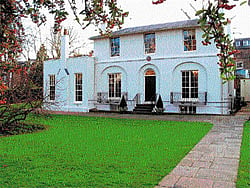
Here, Keats wrote most of the Great odes and fell in love with the ‘girl-next-door’, Fanny Brawne — to whom he also wrote some of the most inspiring love letters of all time.
From Wentworth Place, Keats used to walk up the Vale of Health, a verdant surrounding, to meet the poet and journalist Leigh Hunt who lived there.
Raining, with just a copy of the International Herald over my head, I went Leigh Hunt-hunting on Hampstead Heath. It was Hunt who first realised Keats’ powers and published him in his The Examiner. I rang the door of a kind lady who enlightened me that “some writers did live in the houses on the Heath… an Indian poet too”.
Puzzled, I took the path down. Guess who the Indian poet was who had lived on the heath? Tagore!
A little to the right, I discovered that D H Lawrence also once lived in one of the houses close by. My Hunt-hunt was not in vain! I was directed to yet another house where Leigh Hunt was supposed to have lived, but no, it was the house where the novelist Compton Mackenzie lived, and wrote Whisky Galore! So, where was Hunt’s house? Another lady had this to say, “Hunt was always changing places, fleeing from his creditors. But go deeper right, you’ll find a house with a blue round plaque that says ‘Leigh Hunt lived here’, all covered with a wild growth of wisteria, but it is now a private residence.” This completed my mission. My adventure complete, I trudged back to Keats House.
Keats House sells tickets valid for a year. Presently a single house, it was once two separate cottages partitioned by a wall during Keats’ time. The entry room selling tickets houses Keats-related memorabilia, books on his life, poems, and even a five-foot bust, as tall as Keats himself.
A glass case contains inter alia, Keats’ poem on a folio of a Shakespearean play, his annotations on Lear’s daughters in a copy of King Lear, and, the invaluable engagement ring he slid into Fanny’s finger; the one he wanted back when he knew his life was turning to hopeless death, the one she would not let go. The certificate issued to Keats to practise as a physician is on the wall. This room was then occupied by Fanny Brawne who stayed with her mother, sister and brother. The room above it was her bedroom, and below it, their kitchen.
We move to the room on the right (originally another cottage) where Keats sat and read. A chair is positioned, just as it was in the famous painting by Severn, which portrays Keats seated in a chair reading Shakespeare in window light. To the left we have the room with a window facing the garden. Here, Keats is supposed to have laid on a ‘sofa bed’ (a bright green replica is provided), fashioned by his co-occupant, Charles Brown, at a time when he was severely unwell and unable to move.
Lying on it, he would have gotten a glimpse of Fanny, whenever she walked into the garden. We come up the landing to Fanny’s room, a room that also housed her mother. Fanny had access to some of the best fashion magazines of the day. Examples of the embroidery of Fanny’s time are on display. She loved fashion, embroidery and Keats to the very end, though she would go out to dance with army officers and was known to have once said, in her wealthier days, that she had “overrated” the dying poet. Walking the aisle,we pass Keats’ bedroom on the right, and go past pictures of Maria Crowther, the sail ship in which, Keats, in his advancing consumptive state, sailed to Italy hoping he would some day get back to Fanny.
We come out to an extension built by an actress who later came to acquire the property, and walk out into the well laid green. Does the tree under which Keats wrote his Ode To a Nightingale still exist? Sadly no, says the keeper. “The tree was to the side of the garden where presently is a library. It fell down some time in 1916 or so, but we have a plum tree on the other side, planted in its memory.”
I walk to the tree that has tempting red plums moist in the rain, pluck one, and sip its juice. Bright red smeared on my hand, I’m suddenly reminded of Keats’ horror as he coughed up blood — “I know the colour of that blood; it is arterial blood... that drop of blood is my death warrant.” The plum tree swayed gently, a thing of beauty, oblivious of its surrounding saga of immortality.
